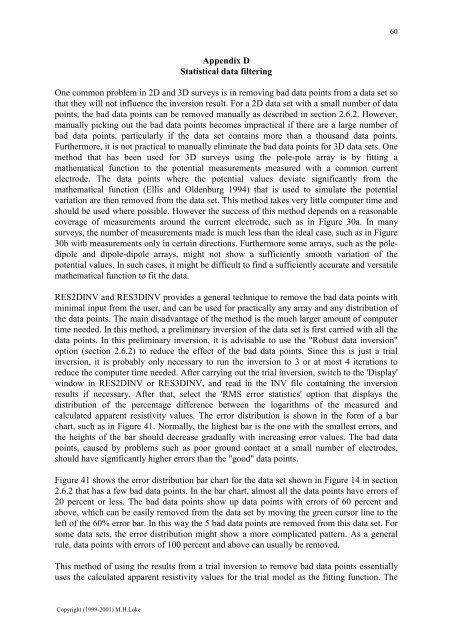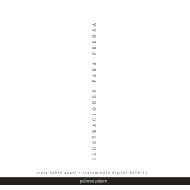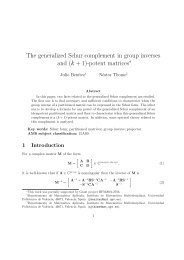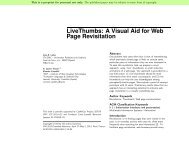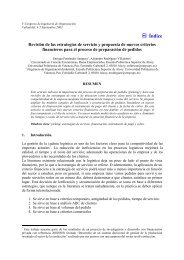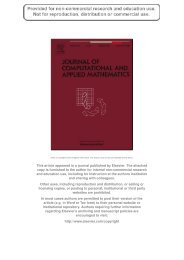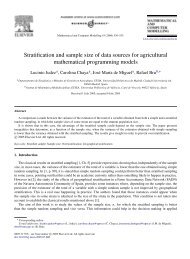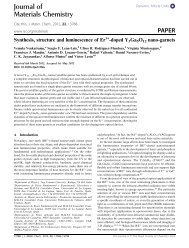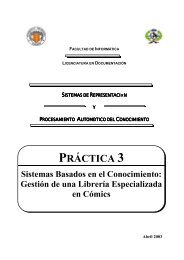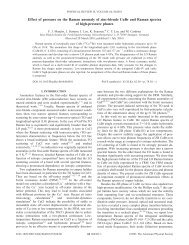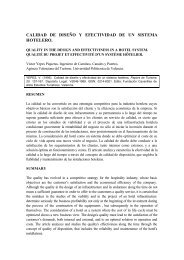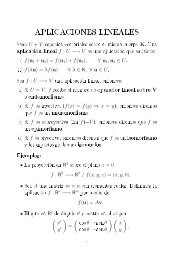Introduction to the resistivity surveying method. The resistivity of ...
Introduction to the resistivity surveying method. The resistivity of ...
Introduction to the resistivity surveying method. The resistivity of ...
You also want an ePaper? Increase the reach of your titles
YUMPU automatically turns print PDFs into web optimized ePapers that Google loves.
60<br />
Appendix D<br />
Statistical data filtering<br />
One common problem in 2D and 3D surveys is in removing bad data points from a data set so<br />
that <strong>the</strong>y will not influence <strong>the</strong> inversion result. For a 2D data set with a small number <strong>of</strong> data<br />
points, <strong>the</strong> bad data points can be removed manually as described in section 2.6.2. However,<br />
manually picking out <strong>the</strong> bad data points becomes impractical if <strong>the</strong>re are a large number <strong>of</strong><br />
bad data points, particularly if <strong>the</strong> data set contains more than a thousand data points.<br />
Fur<strong>the</strong>rmore, it is not practical <strong>to</strong> manually eliminate <strong>the</strong> bad data points for 3D data sets. One<br />
<strong>method</strong> that has been used for 3D surveys using <strong>the</strong> pole-pole array is by fitting a<br />
ma<strong>the</strong>matical function <strong>to</strong> <strong>the</strong> potential measurements measured with a common current<br />
electrode. <strong>The</strong> data points where <strong>the</strong> potential values deviate significantly from <strong>the</strong><br />
ma<strong>the</strong>matical function (Ellis and Oldenburg 1994) that is used <strong>to</strong> simulate <strong>the</strong> potential<br />
variation are <strong>the</strong>n removed from <strong>the</strong> data set. This <strong>method</strong> takes very little computer time and<br />
should be used where possible. However <strong>the</strong> success <strong>of</strong> this <strong>method</strong> depends on a reasonable<br />
coverage <strong>of</strong> measurements around <strong>the</strong> current electrode, such as in Figure 30a. In many<br />
surveys, <strong>the</strong> number <strong>of</strong> measurements made is much less than <strong>the</strong> ideal case, such as in Figure<br />
30b with measurements only in certain directions. Fur<strong>the</strong>rmore some arrays, such as <strong>the</strong> poledipole<br />
and dipole-dipole arrays, might not show a sufficiently smooth variation <strong>of</strong> <strong>the</strong><br />
potential values. In such cases, it might be difficult <strong>to</strong> find a sufficiently accurate and versatile<br />
ma<strong>the</strong>matical function <strong>to</strong> fit <strong>the</strong> data.<br />
RES2DINV and RES3DINV provides a general technique <strong>to</strong> remove <strong>the</strong> bad data points with<br />
minimal input from <strong>the</strong> user, and can be used for practically any array and any distribution <strong>of</strong><br />
<strong>the</strong> data points. <strong>The</strong> main disadvantage <strong>of</strong> <strong>the</strong> <strong>method</strong> is <strong>the</strong> much larger amount <strong>of</strong> computer<br />
time needed. In this <strong>method</strong>, a preliminary inversion <strong>of</strong> <strong>the</strong> data set is first carried with all <strong>the</strong><br />
data points. In this preliminary inversion, it is advisable <strong>to</strong> use <strong>the</strong> "Robust data inversion"<br />
option (section 2.6.2) <strong>to</strong> reduce <strong>the</strong> effect <strong>of</strong> <strong>the</strong> bad data points. Since this is just a trial<br />
inversion, it is probably only necessary <strong>to</strong> run <strong>the</strong> inversion <strong>to</strong> 3 or at most 4 iterations <strong>to</strong><br />
reduce <strong>the</strong> computer time needed. After carrying out <strong>the</strong> trial inversion, switch <strong>to</strong> <strong>the</strong> 'Display'<br />
window in RES2DINV or RES3DINV, and read in <strong>the</strong> INV file containing <strong>the</strong> inversion<br />
results if necessary. After that, select <strong>the</strong> 'RMS error statistics' option that displays <strong>the</strong><br />
distribution <strong>of</strong> <strong>the</strong> percentage difference between <strong>the</strong> logarithms <strong>of</strong> <strong>the</strong> measured and<br />
calculated apparent <strong>resistivity</strong> values. <strong>The</strong> error distribution is shown in <strong>the</strong> form <strong>of</strong> a bar<br />
chart, such as in Figure 41. Normally, <strong>the</strong> highest bar is <strong>the</strong> one with <strong>the</strong> smallest errors, and<br />
<strong>the</strong> heights <strong>of</strong> <strong>the</strong> bar should decrease gradually with increasing error values. <strong>The</strong> bad data<br />
points, caused by problems such as poor ground contact at a small number <strong>of</strong> electrodes,<br />
should have significantly higher errors than <strong>the</strong> "good" data points.<br />
Figure 41 shows <strong>the</strong> error distribution bar chart for <strong>the</strong> data set shown in Figure 14 in section<br />
2.6.2 that has a few bad data points. In <strong>the</strong> bar chart, almost all <strong>the</strong> data points have errors <strong>of</strong><br />
20 percent or less. <strong>The</strong> bad data points show up data points with errors <strong>of</strong> 60 percent and<br />
above, which can be easily removed from <strong>the</strong> data set by moving <strong>the</strong> green cursor line <strong>to</strong> <strong>the</strong><br />
left <strong>of</strong> <strong>the</strong> 60% error bar. In this way <strong>the</strong> 5 bad data points are removed from this data set. For<br />
some data sets, <strong>the</strong> error distribution might show a more complicated pattern. As a general<br />
rule, data points with errors <strong>of</strong> 100 percent and above can usually be removed.<br />
This <strong>method</strong> <strong>of</strong> using <strong>the</strong> results from a trial inversion <strong>to</strong> remove bad data points essentially<br />
uses <strong>the</strong> calculated apparent <strong>resistivity</strong> values for <strong>the</strong> trial model as <strong>the</strong> fitting function. <strong>The</strong><br />
Copyright (1999-2001) M.H.Loke


